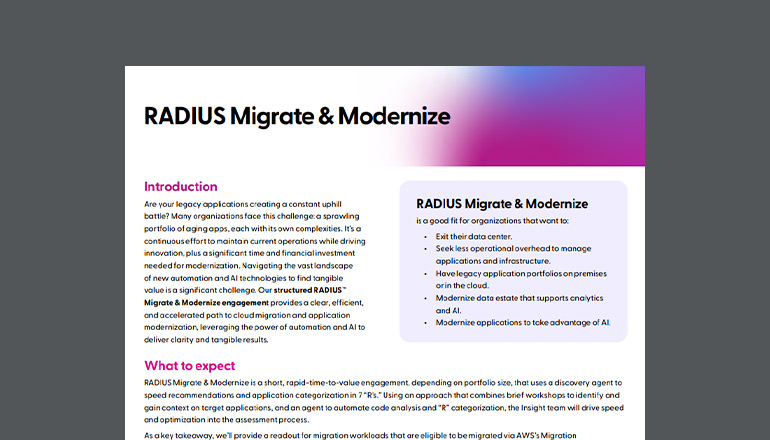Blog 10 Critical Culture Change Elements in Agile Transformation
While Agile was once considered a software development methodology, it has evolved over the past few decades into a much broader set of values embraced by organizations across every industry.
By Nan Hatch / 14 Aug 2019 / Topics: Application development

Designed to empower flexibility, accelerate time to market and improve product quality, Agile enables organizations to respond more effectively to rapid and ongoing changes in the marketplace. But shifting from a Waterfall to an Agile framework requires more than a casual commitment. Adopting and sustaining true agility requires a cultural shift that begins at the heart of your business and extends throughout.
Agile values include willingness to adjust to changes in requirements, collaboration with customers, interaction within the development teams, and frequent and incremental delivery. This approach is in stark contrast to more traditional values of negotiated and elaborate fixed requirements, silos of closely controlled processes and infrequent delivery of major changes of functionality. A change of this magnitude is highly disruptive and can be intimidating for those involved.
Use the following guidelines to ease the transition and improve your probability of success:
- Have a compelling reason to change.This is the single most important piece of the equation and will serve as the foundation for success or failure moving forward. Every member of your organization needs to understand why the shift to Agile is taking place in order to understand why they should change the way they do their jobs. They must make an emotional commitment to the change and respond with more excitement and determination than fear.
Learning takes work, and most people won't alter their behavior without a good reason relevant to themselves — someone else’s bonus is more likely to discourage than to motivate them. Often, large-scale changes occur in response to a clearly perceived threat, but they can also come about as a way to accomplish an exciting goal, such as mastering new technology that will open up new markets. Be sure to clearly communicate the driving factors behind Agile adoption in order to encourage universal buy in. - Publicize management commitment to change. Have your vice president — or higher — let everyone know there's management support for Agile. Not only does executive leadership’s public support demonstrate the importance of your Agile transformation, but it also leads to increased commitment to change overall.
Combined with a clear explanation of the reason to change, such an endorsement can focus and motivate your workforce. Note that it's also important to repeat this commitment consistently — if it's seen as management’s “flavor-of-the-month” brainchild, people will simply tune it out and wait for the next month’s flavor. - Draw on expertise. It’s easier to adopt new behaviors when there’s someone who can demonstrate them, recognize areas for improvement and applaud when things are done well. Consider your existing workforce — are there people within your organization who are already familiar with Agile processes? If so, find ways to leverage their experience and expertise. If not, you may need to consider bringing in some outside expertise to advise and train the rest of your staff. Additionally, it's important to establish which variety of Agile you're planning to implement — Scrum, XP, Kanban, etc.
- Motivate the team. Since they'll be the ones doing the majority of the work, it’s crucial en ensure your development team members are fully committed to the Agile framework. (It’s even more effective if they lead the change effort.) Take the time to clearly and consistently communicate the reasons for change in terms that address the needs of your team. You'll probably have some team members who are more skeptical or cynical than others. Demonstrated success is the single best argument to alter this perspective, so do all you can to provide some “quick wins” during the early stages of Agile adoption.
- Reorganize for team structure. Unlike a traditional Waterfall framework, Agile requires work to be completed in teams. This means your organizational structure may need to shift from functional silos to product-based, cross-functional teams. It's not essential to change the manager to whom the team members report, but it is necessary for all managers involved to agree upon a universal set of expectations and standards. You'll probably want to reorganize physical space as well to provide easier communication among team members. If your team is not located in the same geographic area, you must enable tools to let them collaborate often and share their work products.
- Redefine accountability. Once work has been assigned to each team, management will need to hold those teams — rather than individuals — accountable for success. Previously, employees may have relied on the networking guru, for example, or on the two testers who knew every function in the system. In order to move from thinking and working as individuals to thinking and working as cross-functional teams, everyone in the organization will need a fundamental shift in perception. The guru and the testers will be assigned to teams, and not only they but everyone else will need to stop expecting them to carry the whole load. This way, the team will be able to make progress even when the guru takes a vacation or a maternity leave or comes down with the flu.
We’re here to help you adjust to new ways of working. Explore our resources for enhancing productivity, collaboration and security during this transitional time.
- Expect and support culture change. For most organizations making a transition to Agile, the shift will require new structures to support corresponding changes in thought and behavior. Look at existing reward programs and patterns of behavior. Do your programs support teamwork or competition? Sharing or hoarding information? Direct or indirect communication? Managers and coaches will need to start modeling collaborative, energetic, customer-focused behavior and revising formal policies to support Agile values.
- Allow for a learning curve. NNew behaviors become easier with time. It's unreasonable to expect everyone to adapt immediately and perfectly. You can expect to repeat your values and reasons for change many times before they truly sink in. Allow for some initial awkwardness and for a few steps backward now and again. In particular, some members of your teams may initially be unwilling to share their knowledge for fear they'll make themselves redundant. It will take time and positive experiences to persuade them to trust the team or the process.
- Don’t forget human resources. Because Agile transformation involves changing the way people work, it also requires changes to the way people are managed. Both the structures and processes of employment may need to adapt.
- Measurement of progress and achievement may need to shift. It’s highly likely that your pre-transformation performance appraisal forms are designed to consider individual effort, not team results. But for Agile processes to be successful, individuals will need to pitch in and help one another. Don’t undermine this behavior by blaming or rewarding any one individual to encourage behavior that doesn't support the team as a whole.
- Job descriptions may need to change. As cross-functional teamwork improves, several team members may help with the testing, testers may help with functional definition, and back-end developers may learn more about layout and visual consistency. Eventually, all team members’ jobs will evolve to include more skills, and expectations for new team members will be very different from what they were before the transformation. In order to recruit, train, support and retain team members, the organization will need to redefine their job descriptions.
- Training programs may need to change. In addition to training programs in the new Agile values and processes, your organization may need to making adjustments to trainings for job evaluation, coaching and feedback, peer-to-peer interaction and other interpersonal skills.
- Compensation may need to change. As your team becomes more successfully cross-functional, team members will expand their competence beyond previous areas of specialization. They'll become more valuable both to your organization and the marketplace as a whole. Counseling may be needed for those who can't or won't change. Change is hard, and not everyone will be able or willing to make a transformation to Agile values and processes. Others may need help adjusting their attitudes to the change.
- Remember, Agile is a journey, not a destination. Will you end up with perfect Agile framework right away? No. There will still be politics, conflicting priorities from different managers and cranky team members. But, you can make an enormous transformation in the way your employees interact and therefore increase both your quality and speed to market. Using these guidelines, you'll be able to adapt to changes in your environment and leverage the energy and wisdom of your employees to improve business outcomes.




